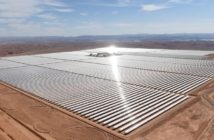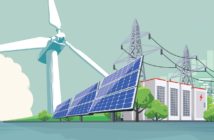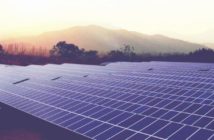Examiner.com by Sandy Dechert
RENEWABLE ENERGY

Sun-powered SolarImpulse aircraft flies to Morocco on no gas at all, next headed for Far East.
TRENDS: U.S.-China solar trade wars heat up, Japanese people disavow nuclear, Germany’s new 10 point plan for Energiewende and energy transition, China pledges to cut energy use and pollution generation. SOLAR: New 300 MWSuntech module, SolarImpulse to make Far East flight, South Korea invests in U.S. solar, Indian incentives to buy U.S. solar film PV… WIND: Filasa invests in Romania… HYDRO: Four small hydropower projects for Uttar Pradesh…TRANSPORTATION: Compact Indian “nano” vehicle runs on air… FRACKING: China revs up for shale gas production with Shell.
Japanese survey reveals almost 50% favor no nuclear future
Reactor meltdowns, radiation leaks, mass evacuations, and fishing and farm losses forced by the March 11, 2011, earthquake and tsunami at Tokyo Electric Power Company’s Fukushima Daiichi plant–coupled with weekly anti-nuclear protests outside the Prime Minister’s official residence–led the Japanese govenment to consult the people about nuclear power via multi-step phone and town meeting polling.
The survey concluded with a two-day face-to-face meeting of representatives in Tokyo in early August. The government had proposed three energy options for the nation: Zero nuclear, 15% nuclear, and 20-25% nuclear. Almost half of those polled (47%) chose the no nuclear policy, with 16% endorsing the middle of the road and 13% opting for 20-25% nuclear. Japan will use these results in drafting a long-term energy policy with zero nuclear power in the 2030s.
Germany’s record renewables use and new energy plan
Germany reaped some of the rewards of its aggressive commitment to renewable energy in the first half of 2012. Its power production from renewables topped 25% (the 2011 annual figure was 21%). The country’s federal association of energy and water estimated that Germany produced 67.9 billion kWh of renewable energy in the first two quarters of this year. Wind energy was the largest contributor to this figure, amounting to almost 10% (9.2%) of the total. Biomass power made up 5.7%; solar, 5.3%; hydro, 4%; and waste-to-energy, 0.9%. Solar energy had the largest gain over 2011: 47%.
Three months into office, Germany’s environment minister, Peter Altmaier, has laid out a 10-point plan for energy transition. Because technology is changing so quickly, as well as world affairs and climate, Altmaier is reluctant to characterize his effort as a master plan. He doubts that any plan compiled today would be valid in 20 years.
Among the plan’s elements:
strengthening European Union emissions reductions targets for 2020;
forming a group of Energiewende (Energy Turnaround) nations (Scandinavian countries come to mind as natural partners for Germany in this respect); and
three new departments within the environmental ministry (Energiewende, climate protection, and citizen participation).
“The Energiewende is the biggest undertaking since post-WWII reconstruction,” observers say. Altmaier also wants to revamp Germany’s Renewable Energy Law, which set the feed-in-tariffrates for renewables this year.
China to cut energy use, pollution generation
The nation of China, the world’s biggest producer of renewable energy and the world’s biggest emitter of greenhouse gases, has pledged to invest $372 billion in energy conservation and environmental safeguards over the next three and a half years.
The move comes as part of an effort to cut domestic energy use by 2015 by the equivalent of 300 million tons of standard coal (16% lower than 2010 levels). Steel producers are mandated to reduce their energy use per unit of production by 25% over 2010-2015; coal-fired power plants, by 8%; and cement manufacturers by 3% “Over the past few years,” Kathy Chen and Stian Reklev report for Reuters, “China has phased out thousands of old, inefficient factories and fossil fuel-fired power plants while becoming the world’s biggest producer of renewable energy.”
U.S. – China renewable trade wars heat up
China’s Commerce Ministry said late in August that measures supporting wind, solar, and hydroelectric programs in several U.S. states (including Massachusetts, Ohio, and New Jersey) violate World Trade Organization rules.
In May and August, the U.S. imposed stiff tariffs(up to 31%) on wind turbine towers and solar panel imports from China.To protect Chinese exports, the United States must cut support for six government-backed renewable energy programs or face unspecified penalties, the ministry said.
The American presidential candidates are divided on the issue. Romney says that Obama has poor economic insight and is soft on China; Obama sees Romney as promoting policies that would endanger renewable energy in the important political swing states.
SOLAR ENERGY
Suntech Power Holdings Co., Ltd., the world’s largest producer of solar panels, is now offering a 300W solar module that will lower balance of system costs and generate a better levelized cost of electricity for commercial and utility-scale solar projects in North and South America.
Suntech has regional headquarters in China, Switzerland, and the United States, and gigawatt-scale manufacturing capability worldwide.
The new module comes with an improved frame design and is built according to standards outlined by Underwriters Laboratories, the leading U.S.-based independent product safety organization. Other advantages: reduced frame thickness and total weight, lower total shipping, handling and storage costs, longer string series than allowed by the earlier 600V industry standard, and 19% more power than Suntech’s older-generation Vd-Series modules. In addition, the new 300W panels will not be subject to U.S. import tariffs recently imposed on solar cells produced in China.
Bertrand Piccard, the Swiss entrepreneur responsible for the world’s first fully solar-powered aircraft, has announced that he plans a round-the-world trip from Switzerland, through Abu Dhabi, to the Far East by the end of next year. Piccard’s solar airship, “SolarImpulse,” flew from Payerne to Morocco and back late in July.
ReneSola Ltd, a leading manufacturer of solar modules and wafers, today announced it has agreed to sell 4.6 MW of its high-quality, high-efficiency 255-watt poly modules to Solar Planet Power Inc., a U.S. company specializing in photovoltaic (“PV”) system solutions for commercial properties, including system due diligence, financing, design, and installation.
Two South Korean companies, Nexelon and Hanwha, are launching large-scale operations in the United States, hoping for a piece of our utility business. Nexelon is dealing with San Antonio, Texas, to bring 400MW of power and many long-term job opportunities to Texas. Hanwha will fold in California-based Solar Monkey and sell SolarOne panels to service a pipeline estimated at over one gigawatt.
Between 2009 and 2012, India went from practically no solar to almost to 1,000 MW of solar installations, remarkable growth over only three years. The populous and developing country instituted a National Action Plan on Climate Change in 2010. Although India has a protectionist policy for crystalline PV cells, its lack of restraints on thin-film PV technology (about 60% of installed capacity) have allowed the US Exim Bank and OPIC to offer rates of interest as low as 3% and a long repayment schedule to Indian solar developers who buy thin-film panels manufactured by American companies. Indian solar thus funds 200 U.S. jobs at First Solar’s manufacturing facility in Perrysburg, Ohio.
The Indian Centre for Science and Environment has accused the U.S. fast-start financing program, a $30 billion fund set up under the United Nations Framework Convention on Climate Change, of pushing India’s domestic thin-film solar PV industry into a state of forced closure and debt restructuring. At the same time, Indian solar power developers are placing orders in the U.S.
WIND ENERGY
Filasa International, a French company, announced on August 31 that it plans to invest about $1.8 billion in ten wind parks in Romaniaduring the coming years. Filasa plans nine wind parks with an 897 MW total installed capacity in Buzau and Braila, and another in Suceava with a 516 MW capacity.
HYDROPOWER
The Indian state of Uttar Pradesh has planned four small hydropower projects that will produce about 3.4 MW, HydroWorld.com reports. Commissioing of all the hydropower plants is expected by 2016. AMR Power Private Limited will develop Kutubpur and Dhakauli, while Oasis Contractors and Private Limited will develop Betwa-1 and Akbarpur. A recent GlobalData report has shown India’s potential for small hydropower growth to be among the world leaders.
TRANSPORTATION
India’s Tata Motors and Motor Development International (Luxembourg) have a new offering (pictured here) that bypasses both the gas station and the electric grid with its Airpod, a compact “nano” vehicle that seats three people.
It has zero emissions, makes 40 mph, and uses compressed air in pneumatic motors that drive conventional pistons. The French initiated experiments with this type of vehicle fifty years before traditional gasoline engines hit the road. Having demonstrated the viability of two compressed air engines earlier this year, the team is now in phase two of Airpod’s premarket work, developing the details and industrializing production.
“CLEAN GAS”
The month of August marked China’s initial forays into hydraulic fracturing for natural gas. Based on encouraging early results, Royal Dutch Shell began fracking shale for natural gas with the state-controlled China National Petroleum Corporation. Operations extend over a large area of the Fushun-Yongchuan block in the Sichuan Basin.
.






